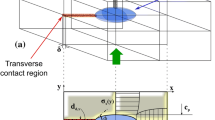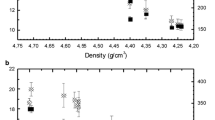Abstract
Pressure tubes holding the uranium rods of a CANDU (CANada Deuterium Uranium) reactor show deformation with time in service. At a certain point, this deformation becomes too severe and the tubes must be decommissioned. This reduces the reactor’s energy output. It has been observed that the microstructure of the pressure tubes is indicative of creep behavior. This paper presents the image analysis procedure used to characterize the level of anisotropy and the α-phase dimension of the Zr-2.5Nb alloy used in pressure tubes. The techniques used to evaluate experimental error and to correct for sampling bias are also explained.
Similar content being viewed by others
References
C.E. Coleman, “Simulating the Behavior of Zirconium-Alloy Components in Nuclear Reactors,” Zirconium in the Nuclear Industry: Thirteenth International Symposium, ASTM STP 1423, ed. G.D. Moan and P. Rudling (West Conshohocken, PA: ASTM International, 2002), pp. 3–19.
D.G. Hurst et al., Canada Enters the Nuclear Age: A Technical History of Atomic Energy of Canada Limited as Seen from Its Research Laboratoires (Montreal, CA: McGill-Queen’s Press, 1997), pp. 234–235.
M. Griffiths et al., “Variability of In-Reactor Diametral Deformation for Zr-2.5Nb Pressure Tube,” Zirconium in the Nuclear Industry: Thirteenth International Symposium, ASTM STP 1423, ed. G.D. Moan and P. Rudling (West Conshohocken, PA: ASTM International, 2002), pp. 796–810.
J.C. Russ. Image Analysis Handbook, Fifth Edition (Boca Raton, FL: CRC Press, 2006), p. 397.
J.C. Russ, Image Analysis Handbook, Fifth Edition (Boca Raton, FL: CRC Press, 2006), p. 400.
M. Sezgin and B. Sankur, “Survey Over Image Thresholding Techniques and Quantitative Performance Evaluation,” Journal of Electronic Imaging, 13(1) (2004), pp. 146–165.
P.K. Sahoo et al., “A Survey of Thresholding Techniques,” Computer Vision, Graphics and Image Processing, 41 (1988), pp. 233–260.
J.N. Kapur, P.K. Sahoo, and A.K.C. Wong, “A New Method for Gray-Level Picture Thresholding Using the Entropy of the Histogram,” Computer Vision, Graphics and Image Processing, 29 (1985), pp. 273–285.
J. Kittler and J. Illingworth, “Minimum Error Thresholding,” Pattern Recognition, 19(1) (1986), pp. 41–47.
Author information
Authors and Affiliations
Corresponding author
Rights and permissions
About this article
Cite this article
Lagacé, M., Rodrigue, L., Hovington, P. et al. Extracting quantitative data from partly revealed anisotropic microstructures as applied to zirconium tubes. JOM 60, 17–21 (2008). https://doi.org/10.1007/s11837-008-0042-y
Published:
Issue Date:
DOI: https://doi.org/10.1007/s11837-008-0042-y




